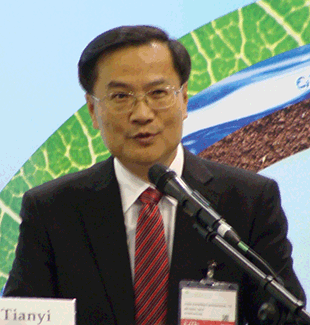More than 330 mass burn WTE plants in place or under construction in China.
 |
| Wang Tianyi, executive director and general manager of plant operator China Everbright International Ltd. addresses EcoExpo Asia 2014 attendees in Hong Kong. |
Mass burn waste-to-energy (WTE) plants have gained favor in China for several reasons, says Wang Tianyi, executive director and general manager of plant operator China Everbright International Ltd., based in Hong Kong.
Wang cited “land savings, odor control and energy production” as factors that have helped mass burn WTE plants gain favor with local governments compared to landfilling solid waste. Wang offered his remarks in a presentation at EcoExpo Asia 2014 in Hong Kong.
As of 2014 Wang says there are 333 WTE plants operating or under construction in China, nearly all of them in the mass burn configuration. The plants offer a combined capacity to handle 30 percent of China’s solid waste, Wang estimated.
He also predicted that the construction of WTE plants will continue in China. “For the next 10 years it will remain a golden period for WTE investment,” he stated.
Wang said the projects can offer from 10 to 15 percent return on investment for companies like China Everbright, a figure capped by government restrictions that “allow for making profit, but not excessive profit,” said Wang.
The successes gained by the WTE sector have not been accomplished without challenges, said Wang. He said little progress has been made in the pre-sorting of collected municipal solid waste to both harvest recyclables and keep unwanted materials out of mass burn plants.
Wang noted that eight trial cities started pilot sorting projects in 2000, but 14 years later “there is not much progress” in any of the cities. In Beijing, he said residents have access to three bins—one for metals, one for food waste and one for other materials. “But in the end we mix them together; we are quite helpless about that,” said Wang.
More recently, he said NIMBY (not in my back yard) challenges to WTE plants have become more common in China. “I think we should try to explain the current [low-emissions] technology,” said Wang. “We can realize no negative impact on people, plus we can give them subsidized electricity.”
Wang acknowledged that the plants will still be perceived as an eyesore, but said China Everbright and other operators can strive to give the plant facades a more attractive “garden-like appearance.”
EcoExpo Asia 2014, organized by Messe Frankfurt (HK) Ltd., was Oct. 29-Nov. 1 at the AsiaWorld-Expo convention center in Hong Kong.
